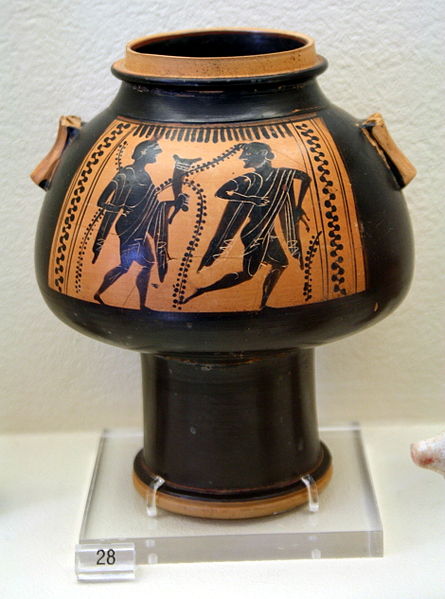An amphora is a type of container with a pointed bottom and characteristic shape and size which fit tightly against each other in storage rooms and packages, tied together with rope and delivered by land or sea. The size and shape have been determined from at least as early as the Neolithic Period. Amphorae were used in vast numbers for the transport and storage of various products, both liquid and dry, but mostly for wine. They are most often ceramic, but examples in metals and other materials have been found. Versions of the amphorae were one of many shapes used in Ancient Greek vase painting.
Amphora designed for marine transport, taken from shipwrecks of the Bronze Age, on display in the Museum of Underwater Archaeology at Bodrum Castle, Turkey. The museum archaeologists have devised a rack and roping device to illustrate how the cargo might have been kept from shifting.
Panathenaic prize amphora in the black-figure style, showing the goddess Athena
Silver amphora-rhyton with zoomorphic handles, c. 500 BC, Vassil Bojkov Collection (Sofia, Bulgaria)
Amphora found in Banpo (China), made by the Yangshao culture; 5000–3000 BC; Guimet Museum (Paris)
Pottery of ancient Greece
Pottery, due to its relative durability, comprises a large part of the archaeological record of ancient Greece, and since there is so much of it, it has exerted a disproportionately large influence on our understanding of Greek society. The shards of pots discarded or buried in the 1st millennium BC are still the best guide available to understand the customary life and mind of the ancient Greeks. There were several vessels produced locally for everyday and kitchen use, yet finer pottery from regions such as Attica was imported by other civilizations throughout the Mediterranean, such as the Etruscans in Italy. There were a multitude of specific regional varieties, such as the South Italian ancient Greek pottery.
Pottery of ancient Greece
Hellenistic Amphorae, stacked the way they were probably transported in antiquity, display in the Bodrum Museum of Underwater Archaeology
Disjecta membra (a fragment of ancient Greek pottery)
Neoclassical "Black Basalt" Ware vase by Wedgwood, c. 1815 AD







